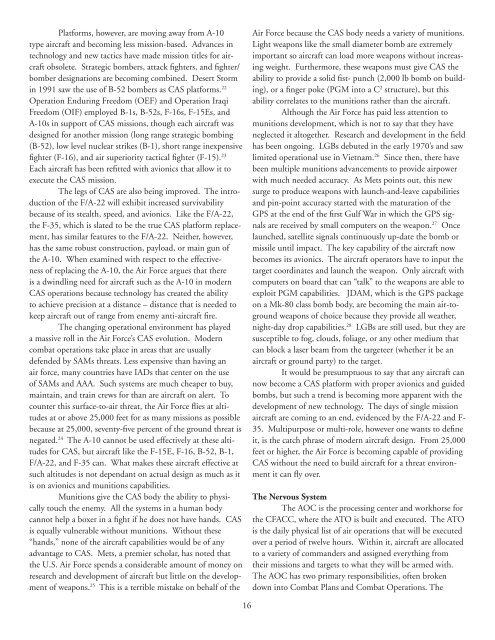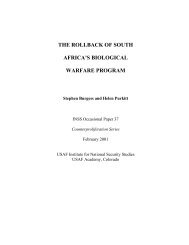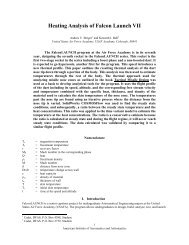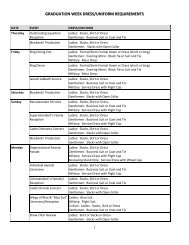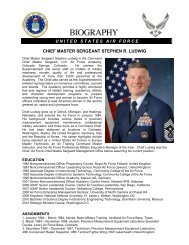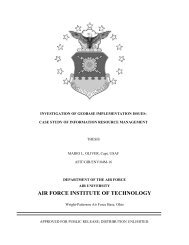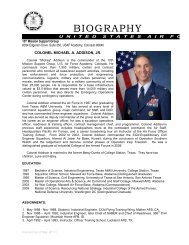Airman Scholar Sp05-1.indd - United States Air Force Academy
Airman Scholar Sp05-1.indd - United States Air Force Academy
Airman Scholar Sp05-1.indd - United States Air Force Academy
Create successful ePaper yourself
Turn your PDF publications into a flip-book with our unique Google optimized e-Paper software.
Platforms, however, are moving away from A-10<br />
type aircraft and becoming less mission-based. Advances in<br />
technology and new tactics have made mission titles for aircraft<br />
obsolete. Strategic bombers, attack fighters, and fighter/<br />
bomber designations are becoming combined. Desert Storm<br />
in 1991 saw the use of B-52 bombers as CAS platforms. 22<br />
Operation Enduring Freedom (OEF) and Operation Iraqi<br />
Freedom (OIF) employed B-1s, B-52s, F-16s, F-15Es, and<br />
A-10s in support of CAS missions, though each aircraft was<br />
designed for another mission (long range strategic bombing<br />
(B-52), low level nuclear strikes (B-1), short range inexpensive<br />
fighter (F-16), and air superiority tactical fighter (F-15). 23<br />
Each aircraft has been refitted with avionics that allow it to<br />
execute the CAS mission.<br />
The legs of CAS are also being improved. The introduction<br />
of the F/A-22 will exhibit increased survivability<br />
because of its stealth, speed, and avionics. Like the F/A-22,<br />
the F-35, which is slated to be the true CAS platform replacement,<br />
has similar features to the F/A-22. Neither, however,<br />
has the same robust construction, payload, or main gun of<br />
the A-10. When examined with respect to the effectiveness<br />
of replacing the A-10, the <strong>Air</strong> <strong>Force</strong> argues that there<br />
is a dwindling need for aircraft such as the A-10 in modern<br />
CAS operations because technology has created the ability<br />
to achieve precision at a distance – distance that is needed to<br />
keep aircraft out of range from enemy anti-aircraft fire.<br />
The changing operational environment has played<br />
a massive roll in the <strong>Air</strong> <strong>Force</strong>’s CAS evolution. Modern<br />
combat operations take place in areas that are usually<br />
defended by SAMs threats. Less expensive than having an<br />
air force, many countries have IADs that center on the use<br />
of SAMs and AAA. Such systems are much cheaper to buy,<br />
maintain, and train crews for than are aircraft on alert. To<br />
counter this surface-to-air threat, the <strong>Air</strong> <strong>Force</strong> flies at altitudes<br />
at or above 25,000 feet for as many missions as possible<br />
because at 25,000, seventy-five percent of the ground threat is<br />
negated. 24 The A-10 cannot be used effectively at these altitudes<br />
for CAS, but aircraft like the F-15E, F-16, B-52, B-1,<br />
F/A-22, and F-35 can. What makes these aircraft effective at<br />
such altitudes is not dependant on actual design as much as it<br />
is on avionics and munitions capabilities.<br />
Munitions give the CAS body the ability to physically<br />
touch the enemy. All the systems in a human body<br />
cannot help a boxer in a fight if he does not have hands. CAS<br />
is equally vulnerable without munitions. Without these<br />
“hands,” none of the aircraft capabilities would be of any<br />
advantage to CAS. Mets, a premier scholar, has noted that<br />
the U.S. <strong>Air</strong> <strong>Force</strong> spends a considerable amount of money on<br />
research and development of aircraft but little on the development<br />
of weapons. 25 This is a terrible mistake on behalf of the<br />
16<br />
<strong>Air</strong> <strong>Force</strong> because the CAS body needs a variety of munitions.<br />
Light weapons like the small diameter bomb are extremely<br />
important so aircraft can load more weapons without increasing<br />
weight. Furthermore, these weapons must give CAS the<br />
ability to provide a solid fist- punch (2,000 lb bomb on building),<br />
or a finger poke (PGM into a C 2 structure), but this<br />
ability correlates to the munitions rather than the aircraft.<br />
Although the <strong>Air</strong> <strong>Force</strong> has paid less attention to<br />
munitions development, which is not to say that they have<br />
neglected it altogether. Research and development in the field<br />
has been ongoing. LGBs debuted in the early 1970’s and saw<br />
limited operational use in Vietnam. 26 Since then, there have<br />
been multiple munitions advancements to provide airpower<br />
with much needed accuracy. As Mets points out, this new<br />
surge to produce weapons with launch-and-leave capabilities<br />
and pin-point accuracy started with the maturation of the<br />
GPS at the end of the first Gulf War in which the GPS signals<br />
are received by small computers on the weapon. 27 Once<br />
launched, satellite signals continuously up-date the bomb or<br />
missile until impact. The key capability of the aircraft now<br />
becomes its avionics. The aircraft operators have to input the<br />
target coordinates and launch the weapon. Only aircraft with<br />
computers on board that can “talk” to the weapons are able to<br />
exploit PGM capabilities. JDAM, which is the GPS package<br />
on a Mk-80 class bomb body, are becoming the main air-toground<br />
weapons of choice because they provide all weather,<br />
night-day drop capabilities. 28 LGBs are still used, but they are<br />
susceptible to fog, clouds, foliage, or any other medium that<br />
can block a laser beam from the targeteer (whether it be an<br />
aircraft or ground party) to the target.<br />
It would be presumptuous to say that any aircraft can<br />
now become a CAS platform with proper avionics and guided<br />
bombs, but such a trend is becoming more apparent with the<br />
development of new technology. The days of single mission<br />
aircraft are coming to an end, evidenced by the F/A-22 and F-<br />
35. Multipurpose or multi-role, however one wants to define<br />
it, is the catch phrase of modern aircraft design. From 25,000<br />
feet or higher, the <strong>Air</strong> <strong>Force</strong> is becoming capable of providing<br />
CAS without the need to build aircraft for a threat environment<br />
it can fly over.<br />
The Nervous System<br />
The AOC is the processing center and workhorse for<br />
the CFACC, where the ATO is built and executed. The ATO<br />
is the daily physical list of air operations that will be executed<br />
over a period of twelve hours. Within it, aircraft are allocated<br />
to a variety of commanders and assigned everything from<br />
their missions and targets to what they will be armed with.<br />
The AOC has two primary responsibilities, often broken<br />
down into Combat Plans and Combat Operations. The


